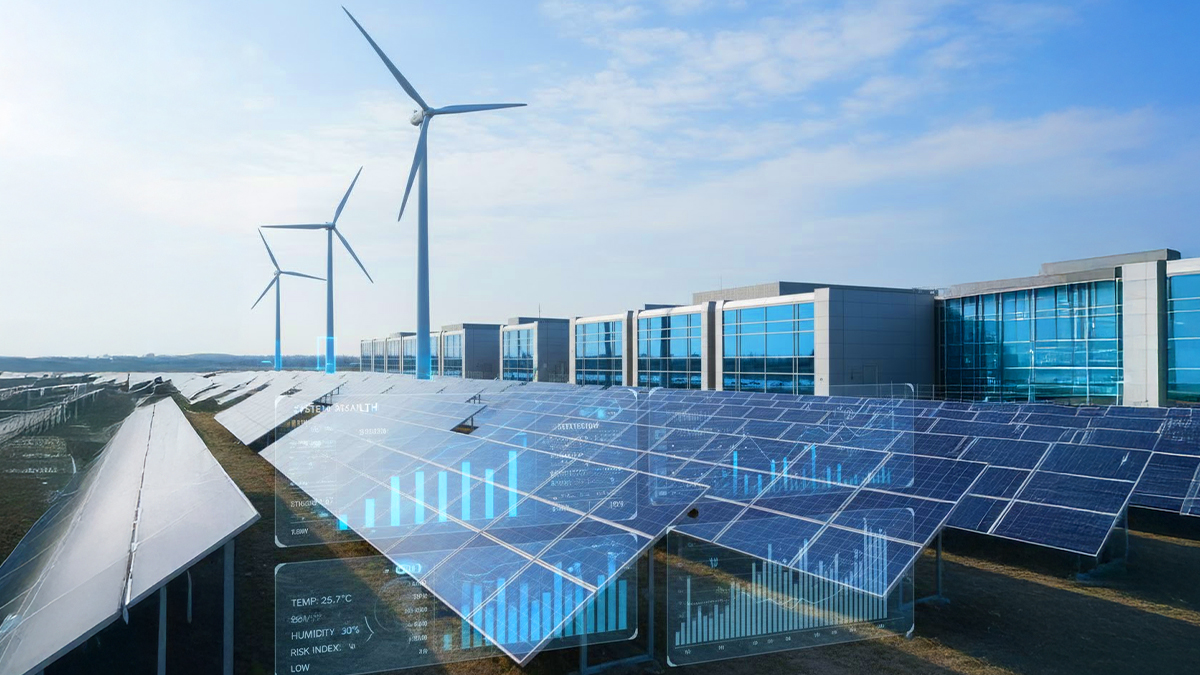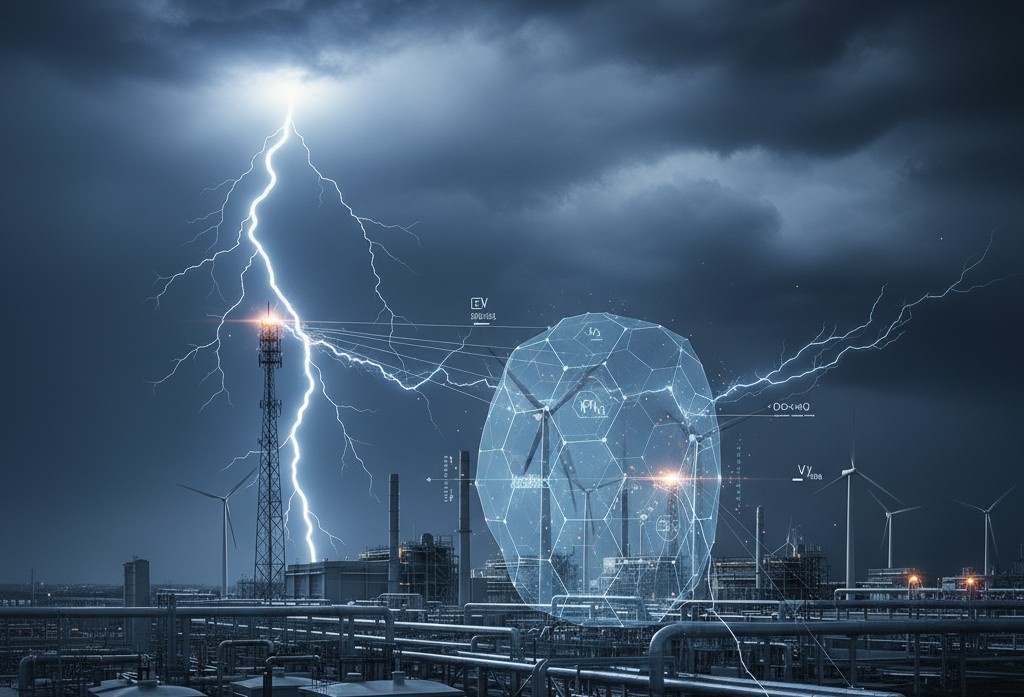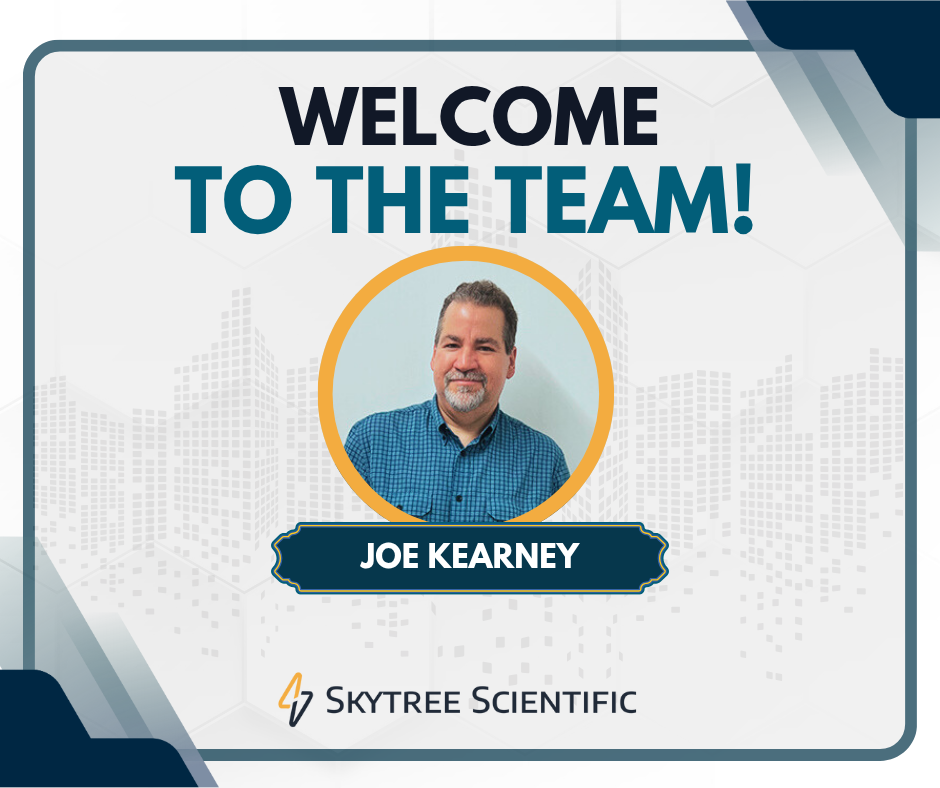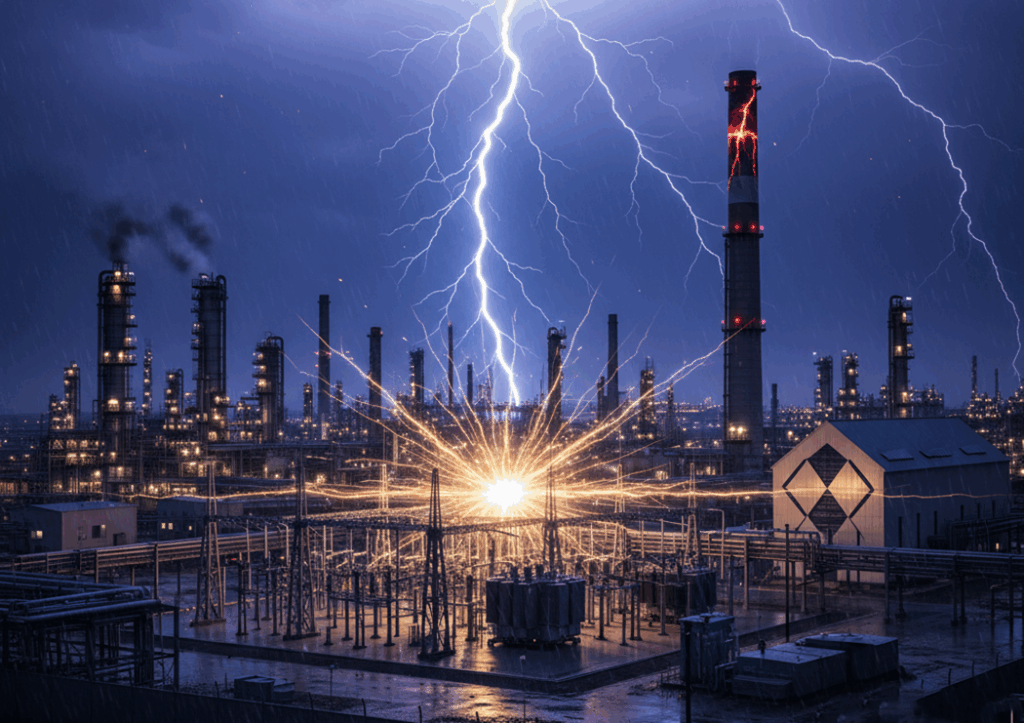The global proliferation of data centers has fundamentally altered energy infrastructure planning. These facilities, driven by explosive growth in cloud computing, artificial intelligence, and digital services, represent concentrated, high-density energy consumers. For renewable energy assets—specifically utility-scale solar farms and wind projects—located near rapidly expanding data center hubs, this proximity introduces a complex and elevated spectrum of operational and financial risks.
Asset owners, facility managers, and risk engineers must move beyond conventional risk management frameworks to address the unique pressures imposed by this infrastructure co-location. This article provides detailed analysis of heightened risks faced by renewable energy facilities in high-demand corridors and outlines actionable risk mitigation strategies focused on strengthening asset resilience, ensuring regulatory compliance, and optimizing long-term operational viability.
Understanding Risk Mitigation in Critical Infrastructure Environments

What is risk mitigation?
Risk mitigation refers to the systematic process of identifying potential hazards that could disrupt operations, evaluating their likelihood and potential consequences, and implementing targeted measures to reduce their impact. In renewable energy operations supporting data center infrastructure, risk mitigation encompasses both proactive strategies that prevent incidents and reactive measures that limit damage when events cannot be entirely avoided.
The approach extends beyond simple hazard avoidance. Effective risk mitigation strategies balance the cost of protective measures against probable losses from unmitigated hazards. For renewable energy assets near data center hubs, this calculation involves equipment replacement costs, lost revenue during outages, contractual penalties for service interruptions, liability exposure, and reputational damage that affects future business opportunities.
Risk mitigation differs from risk transfer mechanisms such as insurance, though both function within comprehensive risk management programs. While insurance provides financial protection after incidents occur, risk mitigation strategies aim to reduce the frequency and severity of those incidents in the first place.
What Is a Good Process for Risk Mitigation?
A robust process for risk mitigation follows a structured methodology that ensures thorough evaluation and consistent implementation across facility operations. The process consists of five interconnected phases forming a continuous improvement cycle.
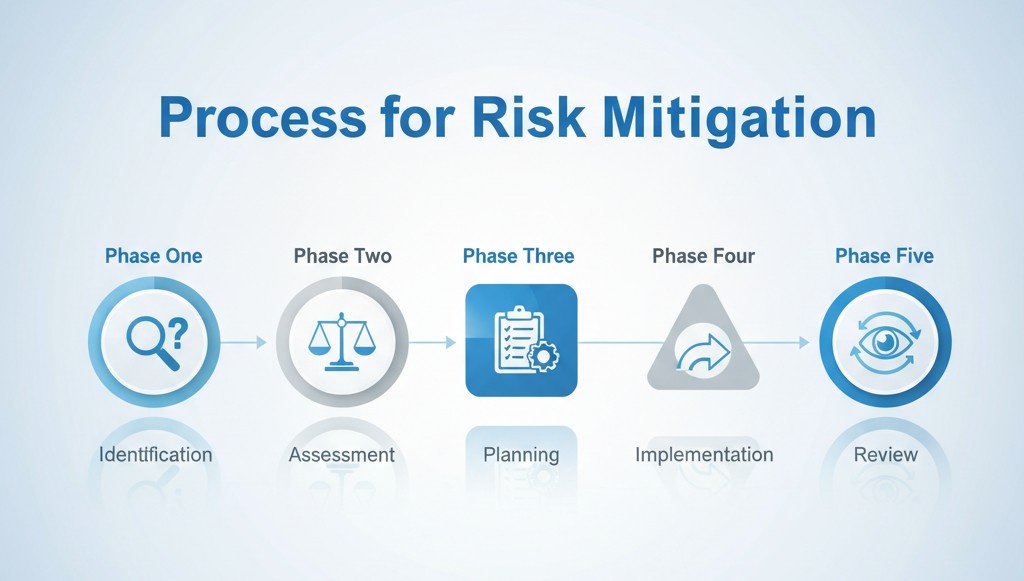
Phase One: Hazard Identification
This initial phase involves a systematic review of operational activities, equipment specifications, site conditions, and external factors. The examination draws on historical incident data, industry loss statistics, engineering analysis, and input from personnel with direct operational experience. For renewable energy facilities, hazards include electrical failures, weather events, equipment degradation, fire risks, and regulatory changes.
Phase Two: Risk Assessment
Identified hazards are evaluated for probability and potential impact. Quantitative methods assign numerical values to likelihood and consequence, producing risk ratings that enable prioritization. Assessment methods account for both individual risks and potential interactions between multiple hazards that could create cascading failures.
Phase Three: Strategy Development
This phase develops risk mitigation strategies tailored to specific hazards and site conditions. Strategies may include engineering controls that physically prevent hazards, administrative controls that modify procedures or training, and protective measures that reduce exposure. Selection considers technical feasibility, cost-effectiveness, regulatory requirements, and operational constraints.
Phase Four: Implementation
Selected risk mitigation strategies are translated into physical installations, procedural changes, training programs, and monitoring systems. This phase requires coordination across engineering, operations, maintenance, and administrative functions. Documentation of implemented measures provides evidence of due diligence and supports compliance verification.
Phase Five: Monitoring and Review
Continuous monitoring tracks the effectiveness of implemented measures and identifies emerging risks. Performance metrics, incident tracking, inspection findings, and equipment condition data inform periodic reviews. This feedback enables adjustment of risk mitigation strategies as conditions change or new information becomes available.
Why Renewable Energy Sites Near Data Center Hubs Face Heightened Operational Risks
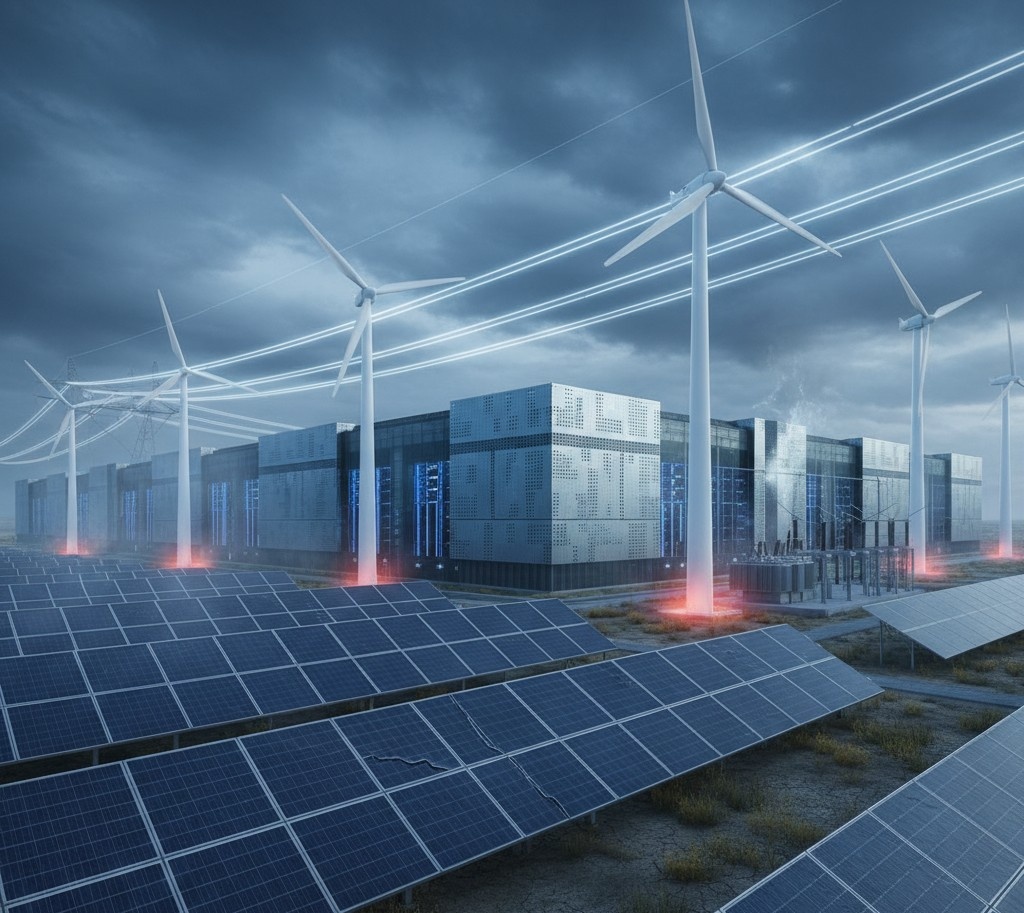
The convergence of renewable energy generation sites and major data center clusters creates infrastructure corridors where operational pressures intensify dramatically. Data centers seek reliable, often renewable, power sources to meet sustainability commitments and immense, uninterrupted load requirements. Renewable energy generators benefit from direct access to premium power purchasers and stable grid connections. However, this relationship drastically amplifies infrastructure stress.
Industry Trends and Infrastructure Pressure: The scale of energy demand from modern data center campuses is unprecedented. A single hyperscale data center can consume power equivalent to a medium-sized city. When multiple facilities cluster in major tech markets, they place immense, localized pressure on regional transmission and distribution networks.
Grid Instability and Congestion: The concentrated, non-dispatchable nature of renewable energy—solar and wind intermittency—clashes with data centers’ need for constant reliability. This necessitates aggressive grid balancing operations and rapid-response ancillary services, increasing the frequency and severity of grid events such as voltage sags, frequency fluctuations, and transient overvoltages that directly impact protective relays and power electronics within renewable assets.
Rapid Infrastructure Build-Out: The speed at which data centers are deployed often outpaces development and reinforcement of supporting transmission infrastructure. This leads to temporary, high-stress conditions on substations, switchyards, and collector systems, increasing the likelihood of electrical faults and equipment failures within nearby generation assets.
Land-Use and Siting Constraints: Competition for land and interconnection points forces new renewable projects into less optimal, sometimes more exposed, geographical areas. Proximity to dense commercial and industrial activity raises environmental and regulatory scrutiny on issues like visual impact, noise pollution from wind farms, and electromagnetic interference.
The primary operational risk stems from the fact that failure in a renewable energy asset is not merely revenue loss but a potential cascading event that could disrupt power supply to mission-critical infrastructure, raising stakes for service interruption penalties and reputational damage.
Risk Factors Affecting Renewable Energy Assets
Inherent risks associated with renewable energy production intensify when assets operate in proximity to dense data center zones. These risks require specific engineering and procedural controls.
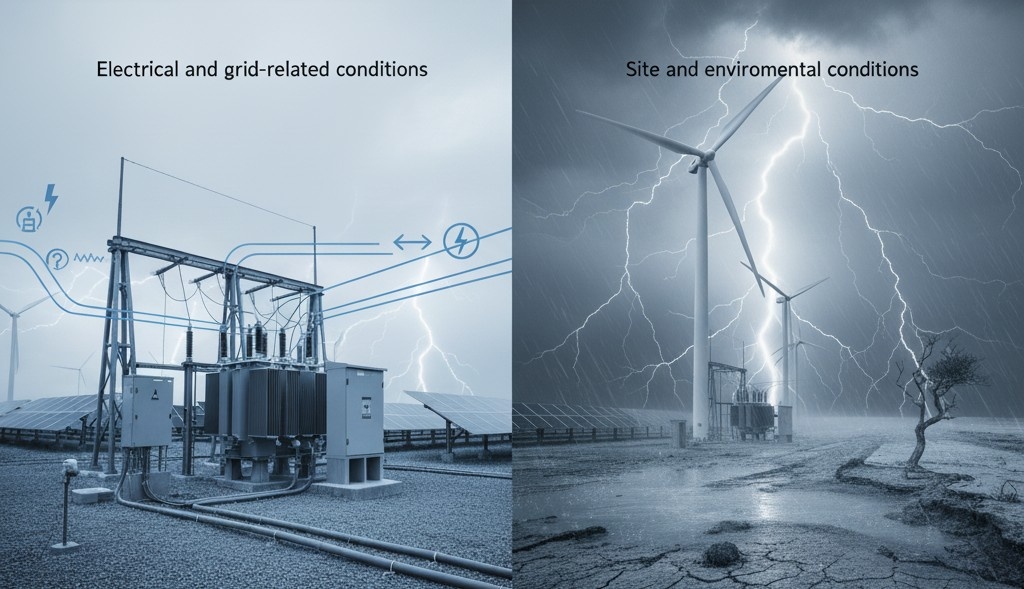
Electrical and Grid-Related Risk Factors
Electrical Faults and Grid Instability: High power throughput and frequent switching actions required to manage data center loads introduce significant harmonic distortion and transient voltage events into localized grid segments.
Inverter stress affects solar photovoltaic and wind turbine inverters, which manage power conversion and grid synchronization. These components are highly susceptible to stress from frequent voltage fluctuations and sustained high temperatures resulting from constant high-load operation. This accelerates degradation of critical components like insulated-gate bipolar transistors and capacitors.
Protection system misoperation can occur when complex fault signatures arising from parallel operations with multiple, massive power consumers challenge the selectivity and speed of protective relaying systems. Incorrect relay settings or slow response times can lead to unnecessary trips or, conversely, catastrophic equipment damage during genuine faults.
Equipment Stress and Thermal Load: The requirement for renewable assets to maximize energy output to meet sustained high demand means operating closer to nameplate capacity limits for extended periods. This continuous high-load regime elevates thermal stress across systems.
Transformer aging accelerates when substation power transformers and medium-voltage collection transformers experience accelerated thermal aging and reduced insulation life under constant high-load factors. Cable and conductor degradation occurs from sustained high current flows and potential heating from proximity to other high-capacity infrastructure, accelerating insulation degradation and increasing fire risk from internal shorts.
Site and Environmental Risk Factors
Fire Risk: The confluence of high electrical load, increased component stress, and dense equipment concentration elevates fire risk. Contributing factors include:
Battery energy storage systems introduce unique thermal runaway risk requiring sophisticated detection and suppression systems, especially when co-located with high-voltage conversion equipment. Arc faults from accelerated aging and mechanical stress can occur in direct current combiner boxes, inverters, or medium-voltage switchgear—high-energy events capable of rapidly escalating into significant equipment loss and site closure.
Lightning Exposure: Utility-scale projects occupying vast, often open terrains remain highly susceptible to atmospheric electrical discharges. Proximity to large metallic structures and complex grid infrastructure associated with data centers can subtly alter localized electrical fields, but the primary concern remains direct and induced effects of lightning strikes.
The density of high-value equipment means a single strike can result in disproportionately large financial and operational losses, particularly given pressure for continuous power delivery. Comprehensive lightning risk analysis becomes essential for assets supporting high-load customers.
Regulatory and Compliance Pressure: The data center industry faces heavy regulation concerning power quality and environmental impact. The renewable asset, as a key part of the supply chain, inherits this elevated regulatory scrutiny. Extended outages or failures leading to environmental incidents near dense industrial zones face far more punitive and immediate regulatory action.
Risk Mitigation Strategies for Enhanced Asset Resilience
Effective risk mitigation in this environment requires a multi-faceted approach integrating sophisticated engineering, stringent operational protocols, and robust financial controls.
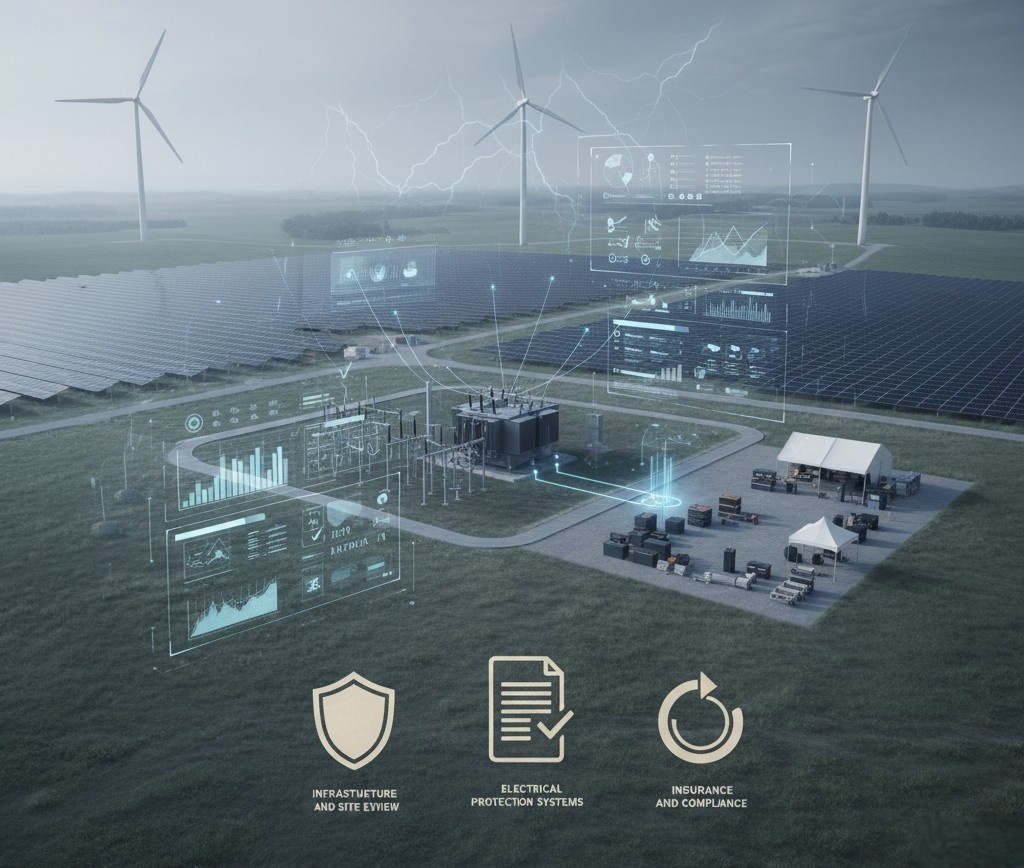
Infrastructure Planning and Site Evaluation
Initial siting and design decisions constitute the most critical risk mitigation strategies.
Advanced Siting Studies: Beyond standard feasibility, conduct comprehensive geotechnical and electromagnetic interference studies. Ensure minimal exposure to known electrical problem areas in grid infrastructure and adequate clearance from high-voltage transmission corridors that could induce transient voltages.
Oversizing and Redundancy: Design systems with higher margins than typical projects. This includes oversizing cooling systems, transformers, and collection infrastructure to accommodate sustained high-load factors without thermal overloading. Incorporate redundancy for mission-critical components, especially control systems and power delivery switchgear.
Sectionalization and Fire Breaks: Implement extensive site sectionalization—smaller inverter blocks, segmented collection feeders—to limit propagation of faults or fires. Integrate physical fire breaks and non-combustible barriers between high-risk zones, such as battery storage units and inverter pads, following NFPA 855 guidance.
Strengthening Electrical Protection Systems
Protection systems must be engineered to handle unique fault signatures and high-speed demands of data center environments.
Adaptive Relay Settings: Utilize smart relays with adaptive settings capable of adjusting protection parameters based on real-time grid conditions rather than static settings. This improves selectivity and speed of fault isolation during complex grid events.
High-Speed Fault Isolation: Invest in high-speed grounding switches and advanced circuit breakers with rapid fault interruption capabilities to minimize arc duration and damage potential from high-current faults.
Transient Voltage Protection: Install multiple layers of surge protection devices throughout the asset—at the module level for photovoltaics, combiner boxes, inverter outputs, and substation busbars. These devices must be appropriately rated for expected transient energy and coordinated to ensure efficient energy dissipation.
Monitoring, Inspection, and Reporting Protocols
Operational intensity necessitates transition from periodic inspection to continuous condition monitoring.
Predictive Maintenance Systems: Deploy advanced supervisory control and data acquisition systems integrated with machine learning algorithms. Monitor key performance indicators such as partial discharge activity in transformers, thermal profiles using continuous infrared monitoring, and vibration analysis in wind turbine drivetrains.
Thermographic and Acoustic Inspections: Conduct high-frequency aerial thermographic inspections of solar arrays and transmission lines to detect failing cells, hot spots, and interconnection issues before they escalate into arc faults. Utilize ultrasonic acoustic imaging to pinpoint partial discharge and corona activity in switchgear and insulators.
Structured Reporting: Establish rigorous reporting frameworks tracking component mean time between failure, fault rates, and operational excursions. This data is essential for accurate warranty claims, insurance underwriting, and future design optimization.
Weather-Related Risk Controls and Lightning Risk Analysis
Extreme weather poses the greatest non-operational threat, and the concentration of high-value equipment means mitigation must be precise and standards-driven.
The cornerstone of robust weather risk programs is thorough lightning risk analysis. This goes beyond merely installing air terminals; it involves systematic assessment of strike probability, potential consequences, and necessary protective measures in accordance with authoritative standards.
Standards-Based Assessment: Adherence to international standards, particularly IEC 62305 and NFPA 780, is paramount. These standards provide methodology for calculating the lightning protection level required for assets based on site characteristics, equipment value, and service criticality.
Advanced Assessment Tools: To deliver the required level of detail for compliance and engineering, risk managers often leverage specialized tools. Skytree Scientific supports this critical assessment function through their structured methodology, LRA Plus™. This platform provides systematic approaches to conducting necessary lightning risk analysis by integrating site-specific parameters, geospatial data, and historical strike data.
LRA Plus™ aids engineers in calculating precise risks, defining necessary protective measures including shielding methods, placement of air terminals, and earthing system design, and generating compliant documentation. This structured assessment and compliance guidance based on IEC 62305 and NFPA 780 ensures that risk mitigation strategies are grounded in proven engineering principles—a crucial factor when assets support sensitive data center operations.
Enhanced Grounding Systems: Implement sophisticated, low-impedance earthing and bonding networks across sites, ensuring all metal structures, equipment frames, and surge protective devices are connected to minimize ground potential rise during strikes and effectively dissipate surge currents.
Workforce Training and Emergency Readiness
Human error remains a primary cause of operational failures. Training must reflect high-stakes, rapid-response environments.
Scenario-Based Training: Develop detailed, scenario-based training protocols for technicians and operators, focusing specifically on managing grid instability events such as islanding and black start procedures and high-energy fault isolation.
Integrated Emergency Response: Establish robust emergency action plans and conduct regular drills coordinating with local first responders, utility operators, and data center facility managers. Plans must include specific procedures for battery storage thermal runaway, major transformer fires, and large-scale grid outages.
Insurance and Compliance Considerations
Financial and regulatory risk management is as crucial as engineering controls within comprehensive risk mitigation strategies.
Customized Insurance Products: Standard property and business interruption insurance may be insufficient. Secure specialized coverage explicitly addressing interruption of service to high-load customers and providing adequate limits for unique perils like battery storage failure. Insurers favor assets demonstrating adherence to standards like IEC 62305 and use of tools for structured risk assessment.
Regulatory Compliance Documentation: Maintain impeccable documentation of all maintenance, inspections, and compliance checks. Demonstrable, structured compliance is powerful mitigation against regulatory fines and a key requirement for reliable data center power supply contracts.
Role of Technology and Data in Risk Management
Technology and data analytics are critical enablers for managing complexity and reducing uncertainty in high-demand power corridors.

Structured Assessments and Accurate Reporting
The transition from qualitative risk assessments to quantitative, data-driven decisions is mandatory. Structured assessments provide repeatable, auditable methodology for identifying, quantifying, and prioritizing risks based on consistent frameworks.
Quantifying Risk Exposure: By structuring assessments—assigning specific values to failure probability, consequences in financial and operational terms, and efficacy of current mitigation measures—risk managers make economically sound decisions regarding capital expenditure.
Enhancing Stakeholder Communication: Accurate, structured reporting converts complex engineering issues into clear financial terms that resonate with executives and insurance underwriters. It validates the need for investment in controls such as advanced protection systems or specialized grounding grids.
How Skytree Scientific Supports Risk Decisions
Tools facilitating structured risk analysis, particularly in high-risk areas like lightning, significantly improve the quality of risk decisions. Skytree Scientific, with its specialized platform LRA Plus™, provides industry-relevant support for implementing effective risk mitigation strategies.
LRA Plus™ is designed to move lightning risk analysis from subjective estimate to defensible, standards-compliant engineering exercise. It aids in:
Structured Assessment Implementation: The platform guides asset owners and engineers through requirements of IEC 62305, ensuring all necessary factors—including asset type, surroundings, consequences of failure, and existing protection—are accounted for in risk calculations.
Compliance Guidance: By facilitating adherence to the strict methodology of IEC 62305 and cross-referencing requirements from NFPA 780, LRA Plus™ provides clear, actionable compliance pathways. This is vital for assets that must prove exceptional reliability and protection to utility companies and data center clients.
Optimizing Protection Design: Structured risk calculation output informs optimal selection and placement of lightning protection measures—ensuring investment in air terminals, down conductors, and surge protection devices is proportional to calculated risk level, avoiding both under- and over-protection.
Integration of such specialized, standards-driven assessment tools enables renewable energy operators to confidently demonstrate to high-demand customers that facility risk profiles have been rigorously quantified and mitigated to the highest industry standards.
Practical Use Cases in High-Load Corridors
Implementation of advanced risk mitigation strategies is most critical for specific asset types operating adjacent to high-load clusters.
Renewable Energy Operators Near Large Data Centers
Consider a scenario where a solar farm is co-located with battery energy storage and dedicated to supplying power to hyperscale data center clusters.
The operator implements high-speed fault detection systems across direct current arrays and inverters, coupled with continuous thermal monitoring of battery storage units. Thorough lightning risk analysis using structured methodology identifies the need for protection across central inverter blocks and step-up substations. The result is the installation of specific low-impedance grounding grids and high-energy surge protection devices, coordinated to prevent damage to inverters—the most vulnerable and expensive components—thereby safeguarding the primary power supply to critical data center loads.
Solar Farms, Wind Projects, and Hybrid Assets
Solar Farms: Solar projects require enhanced grounding systems and rigorous arc fault detection, particularly where photovoltaic string length and output are maximized for high-load customers. Risk mitigation strategies focus on minimizing the probability of fire-induced outages by integrating non-combustible cable pathways and continuous thermographic monitoring.
Wind Projects: Wind assets must prioritize integrity of turbine blades and control systems against lightning. They require sophisticated condition-based monitoring for drivetrains to detect fatigue damage accelerated by constant high-load factors driven by data center demand.
Hybrid Assets: Solar, wind, and battery storage combinations present the highest complexity level. Risk mitigation strategies must focus on interconnection points and power conversion equipment. The battery storage-to-grid interface must have separate, redundant protection schemes ensuring that battery storage failures do not cascade into outages for solar or wind components—a requirement for balancing energy supply in high-load zones.
Conclusion: Reinforcing the Value of Structured Risk Programs
Renewable energy assets near data center hubs face operational demands that require structured, engineering-led risk mitigation strategies. Following a systematic process from hazard identification through continuous monitoring enables operators to reduce vulnerabilities and maintain reliability. Implementing standards-based protections, particularly for lightning exposure through comprehensive lightning risk analysis, and utilizing assessment tools like Skytree Scientific’s LRA Plus™ ensures that facilities meet the stringent requirements of critical infrastructure customers. The future viability of renewable energy in these high-demand corridors depends on this commitment to rigorous risk management.

